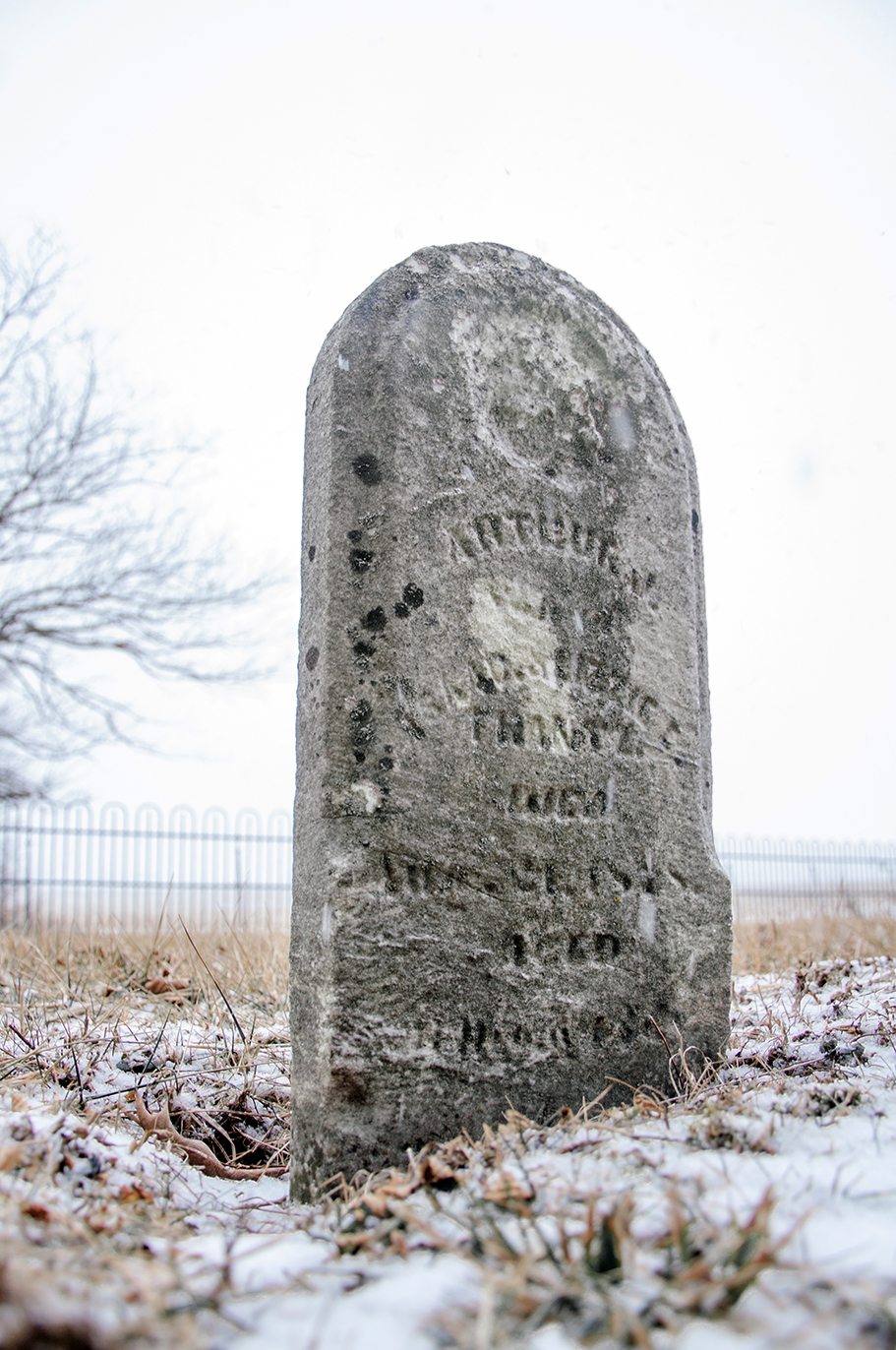 Berry Tells the Tale of Albert Frantz and Bessie Little
Berry Tells the Tale of Albert Frantz and Bessie Little
A grave lies cold in a secluded cemetery off of Studebaker Road, bearing the earthly remains of Albert Frantz, a young man who was convicted of first-degree murder and sent off to be the fourth person executed in Ohio’s electric chair. While Frantz’s story did not begin in New Carlisle, it ended here, after what began as a seemingly harmless ride around town turned into a tumultuous year of death, denial, and deceit.
New Carlisle historian Bill Berry spoke last Thursday, February 11 at the New Carlisle Library, telling his “Sad Story of Albert Frantz and Bessie Little.” Berry said he was first intrigued by the story many years ago after reading Journalist Roz Young’s work on the couple in a Dayton newspaper. He took it upon himself to delve more deeply into the case, and found that the story has undeniable New Carlisle connections, other than the fact that Frantz was buried here more than one hundred years ago. Frantz was related to two prominent New Carlisle families—the Funderburgs and the Studebakers, and it was Frantz’s cousin Isaac Funderburg who retrieved his body from the executioners and brought him back to New Carlisle.
Frantz was just 20 years-old when he was executed on November 19, 1897 for murdering his girlfriend Bessie Little the year before. Berry said Frantz’s case was so bizarre that it gained international attention, nabbing front page headlines from coast to coast. Frantz was a seemingly devoted German Baptist, or Dunkard as they were then known. The Dunkards were a very peaceful, devoted, and God-fearing sect known for being so non-confrontational that they often declared themselves conscientious objectors during times of war so they would not have to fight. They were a very respectable people, never known to break the law—even collectively refusing to fight back or defend themselves in times of personal attack. These factors, along with Frantz’s spotless reputation among those who knew him, made it even more shocking when it was announced that he was the sole suspect in Little’s murder. Berry said that we are so accustomed and desensitized to murder cases in the news these days that we cannot fully appreciate the attraction to this story from the masses back then. The German Baptist Dunkards were the last people anyone would ever suspect of crime, let alone murder, and it could almost be likened to an Amish person being accused of cold-blooded murder today.
Berry said Frantz was born in 1875, the last of seven children, and lived with his parents and siblings in Tadmore, which was a riverside village near the Taylorsville Dam along Route 40 that was later wiped out by the 1913 flood. Frantz’s mother, Phoebe Studebaker-Frantz, was the daughter of Abraham Studebaker of New Carlisle. Frantz’s father Jacob was slowly becoming an invalid during Frantz’s childhood, Berry said, as he had been crippled with a chronic affliction most of his life. Phoebe died when Frantz was 13, leaving the teen boy to care for his father with only the help of his sister Martha, as all of his other siblings were grown and moved out by this time. Frantz took a menial job making five dollars per week, and moved his father and sister from Tadmore to West Second Street in Dayton, where he joined the nearby College Street German Baptist Dunkard Church in 1896. Berry said other members of the church’s congregation regarded Frantz as a highly-respected individual, as he worked hard to take care of his father and was a regular face in the crowd at church.
Not long after moving to West Second Street, Berry said Frantz met Bessie Little, noting that it never takes long for two good-looking single people to find one another, especially living in such close proximity. Berry said Little was the adopted daughter of Peter and Elizabeth Little, who took in the girl from the Troy Infirmary and Children’s Home when she was two years-old.
“Bessie had never had a serious relationship before, but she became quite smitten with Albert,” said Berry.
He noted that Mrs. Little caught Frantz and Bessie in “several compromising positions” over the course of 1896 and, fearing her daughter’s reputation, gave Bessie an ultimatum. Mrs. Little demanded that Bessie marry Frantz or move out immediately. Frantz said that he was not old enough to marry Bessie on his own accord and his father had not given him permission, and Bessie, as love-struck as one can be, decided to move out of her home rather than lose Frantz. (At the time, Ohioans had to be 21 to marry legally unless they had the written consent of their parents).
Mrs. Little scribbled a hasty and quite hateful note to Frantz’s father Jacob, telling him of the situation and asking that he grant Frantz permission to marry her daughter. Mrs. Little never received a response from Jacob, which Berry believes can be attributed to her words in the letter, as she labeled Bessie “a tramp,” saying she was adopted and likely came from a bad family, blatantly telling him about catching the couple in improper embraces.
It was around this time that Bessie began living at a hotel because she was no longer welcome at home, and Jacob still had not granted his son permission to marry her. Bessie wasn’t able to afford living at the hotel after about a week, and soon moved into Minnie Friese’s Boarding House on August 20, 1896, at the insistence of Frantz, who agreed to pay her room and board there. She was at the boarding house one week before she turned up missing—disappearing the night of August 27, when she was supposed to be going out with Frantz.
Friese said Bessie was absolutely elated on the afternoon of August 27, charmed by the prospect of spending the evening with her new love. Bessie ate her dinner at the boarding house that evening before leaving on foot to meet Frantz, and was never seen alive again.
That same evening, the fire department was called to the Frantzes home, as their barn had mysteriously caught fire. Firefighters found a badly-burned buggy inside, along with the horse, who had perished in the blaze. A neighbor of the Frantzes who rushed over in attempt to save the horse, noted to reporters at the time that the barn door had been locked, which was unheard of at that time in that neighborhood.
The next morning, on August 28, Frantz showed up at Friese’s boarding house, looking for Bessie. He reportedly asked Friese if she knew where Bessie was, claiming that she hadn’t shown up for their date the night before. Before leaving, Frantz also paid for another week of room and board for Bessie to stay there if she returned.
One week later on September 4, 1896, while Bessie’s disappearance was still fresh in everyone’s mind, a traveler by the name of E.L. Harper had stopped to beat the late-summer heat by taking a swim in the Stillwater River in Dayton. While swimming, he spied a shoe grazing the water’s surface, and thinking that it was stuck on a stick, Harper swam out to the shoe only to find it attached to a body—Bessie Little’s body—though no one knew who she was at the time.
Her body was examined by Dayton’s Police Chief and Coroner, who both ruled out any signs of violence, concluding that the woman’s death had been a suicide. She was then buried in the Potter’s Field in Dayton’s Woodland Cemetery.
After she was laid to rest, Bessie’s former dentist Levitt Custer called in with Bessie’s dental records, which positively identified the woman as Bessie Little, as well as prompting a search of her room at the boarding house. There, police found an undelivered letter written by Bessie to Frantz’s father Jacob.
The letter implored Jacob to give Frantz permission to marry her, as she was now pregnant with Frantz’s child and out of options. Berry said that Frantz had already told his father about Bessie’s condition and also asked for his permission to marry her, but it was never granted.
Berry said it was important to “read between the lines” in Jacob’s refusal to allow his son to marry Bessie—implying that her character along with her not being a member of the German Baptist Church were probably contributing factors.
Police then questioned Frantz after the search of Bessie’s room. He told them that Bessie likely killed herself because she was very depressed about being pregnant, having nowhere to live, and over his inability to marry her. Unbelievably, the police bought Frantz’s story, even concluding that Bessie had first burned down the Frantzes barn before going to the river and taking her own life.
The next day, September 5, three young men who were fishing and swimming near the Idelwild neighborhood found two tortoiseshell hair combs on the bridge, one of which was lying in a pool of blood. Police examined the scene and found that the combs were discovered about 25 feet apart on the bridge, both covered in blood. They also located the print of a wagon wheel in the blood. After confirming with Mr. and Mrs. Little that the combs had belonged to their daughter, Bessie’s body was disinterred for another examination.
This time, examiners found two gunshot wounds to Bessie’s ear, along with enough lead fragments in her brain to suggest that she was shot with two .34-caliber slugs. Berry said that while he is sure medical examiners today would not miss such an obvious injury, he said it could be understandable in 1896, given the location of the wounds and the fact that Bessie’s body had been underwater for a week before she was found.
On September 6, Frantz was interrogated by Dayton Police. This time, he admitted to them that he was with Bessie the night of her death, only he claimed that she had been the one to shoot herself in the head—twice. Frantz told police that he had taken Bessie for a ride that night, claiming that she had wanted to drive over the Ridge Avenue Bridge to see a boat that had capsized in the Stillwater a few days earlier.
He said he had just turned his head to look down in the water when he heard a shot and then another, and saw that Bessie had shot herself twice in the head. He said he immediately began thinking of the implications so he panicked and threw her gun in the water. The police arrested Frantz immediately but did not charge him right away as they began their investigation, even calling in professional divers from Newport, Kentucky to search the river for the gun, but it was never found.
Frantz was charged with murder in the first degree during the pre-trial and held without bond. During the arraignment, Berry said the prosecutor painted Frantz as a cold-blooded killer who unflinchingly went to Bessie’s boarding house to ask about her while he knew that she was already dead. The prosecution also claimed that Frantz didn’t want to be drawn into a breach of promise suit now that Bessie was unmarried and pregnant with his child, especially when Frantz stood to soon inherit nearly $2,000 from his mother’s estate. They also claimed that Frantz was engaged to marry another young woman in one month’s time, yet Berry said he was never able to substantiate this claim through his research.
As if the case of a Dunkard suspected of killing the pregnant woman he refused to marry wasn’t bizarre enough in the late 1890s, a spectacle in the courtroom would only further ignite the media’s obsession with the sensational far-reaching story.
Berry said that to prove a point, the coroner was called in by the prosecution to describe Bessie’s autopsy. Her head, which had been removed of its skin and kept in a jar of alcohol at the police station for two months, was presented by the coroner, who even took the head out of the jar.
Berry said the chaos this caused in the courtroom was understandable, as many in the audience fainted, several vomited, and some even clamored for a closer view of the morbid spectacle. He said there were numerous German Baptists in the audience as well, noting that the ladies of the church had an especially difficult time with the sight before them. It was reported that the windows in the courtroom had to be opened to alleviate the stench from the air.
The reporters had a field day with the gross display in the courtroom, with one headline reading “Poor Bessie’s Head,” the same publication also noting that Frantz was “horribly fascinated with the skull.”
The prosecution also explained that Frantz had burned down his own barn to rid the wagon of Bessie’s blood, and made a point to tell to the jury that it is nearly impossible for someone to shoot themselves in the head twice. They also tracked down the owner of Dodd’s Sporting Goods store, who sold Frantz a .32-caliber pistol two weeks before Bessie’s murder.
On December 29, 1896, Frantz’s trial came to an end, with the jury deliberating five or six hours before delivering a guilty verdict. Frantz’s family was in the courtroom at the time the verdict was read aloud, causing his brother Cornelius to faint. Frantz himself broke down and had to be carried out of the courtroom.
Berry thinks that Frantz had sincerely convinced himself of his innocence in Bessie’s death. Saying the mind is a very powerful tool, Berry thinks that Frantz was able to remain in such a state of denial over his involvement in Bessie’s death that he ultimately convinced himself that he didn’t do it. Frantz maintained his innocence throughout the trial, even telling his cousin that he was innocent as he walked to the electric chair.
Frantz was originally set to die on May 19, 1897, but appealed the sentence twice. The appeals were both turned down, and he was then scheduled to die on November 19, 1897. Berry said that in 1896, Ohio prison warden E.G. Coffin convinced the state that the standard form of execution by hanging was too inhumane, recommending death by electric chair instead.
Berry said he can’t imagine why anyone would think that the electric chair was less-torturous than hanging, but the initiative passed in 1897, and Frantz was the fourth person to die by the new method.
Despite a well-worded and seemingly sincere letter to Governor Asa Bushnell claiming his innocence and requesting a pardon, Frantz’s execution was to go on, though he did not find out until a mere eight hours before his death. Berry said that Frantz spent the last day of his life in severe pain and anguish, hoping that Bushnell would pardon him as he waited desperately for the letter to come.
Berry said the audience at Frantz’s execution was reported to be the most distasteful ever seen at an Ohio execution, as many were there just for the spectacle, and most of them were really drunk. He said Frantz’s cousin Isaac Funderburg, who was also an undertaker and a witness to the execution, claimed that Frantz walked to his death saying: “I’m innocent.”
Berry said it took three currents to kill Frantz, likely because the method was still new and rather untested. Funderburg then brought the body of his cousin back to New Carlisle, where a large crowd awaited the funeral train at the station. Frantz’s body was laid in state at Funderburg’s grand home for two days before being ceremoniously driven to the Studebaker Road family cemetery for burial.
Bessie Little, who was originally buried in the Potter’s Field section of the Dayton Woodland Cemetery, was later exhumed and re-buried with a more fitting ceremony in another plot.
The Ridge Avenue bridge over the Stillwater River where Bessie met her end is now named for a veterans’ group, Berry said, but was once dedicated in her honor. In fact, he said many longtime Dayton residents still refer to the bridge near Triangle Park and the Boonshoft Museum of Discovery as “the Bessie Little Bridge.”
Berry said he was told during his research that Bessie still regularly haunts the bridge at night.

